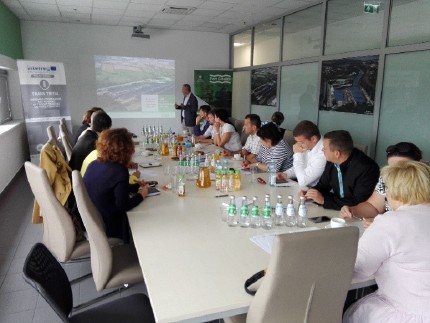Side visit and strategic Workshop at Silesian Logistics Centre
The workshop took place in the seat of the Silesian Logistics Centre and was attended by the Partners' representatives, as well as external stakeholders.
The meeting was divided into two parts, first part, thanks to the hospitality of PCC Intermodal Terminal in Gliwice, started with the introduction of basic information about the Centre, history of the company and the process of its development, as wall as the Gliwicki Canal and Port Gliwice. The significance of its location was highlighted, also in terms of Baltic-Adriatic Corridor. The infrastructure of the Centre, including the storage and handling capacity (railways, waterways, road system), and the services offered were also described. After that whole group of participants was taken on show round over the Centre and the Terminal. We were able to observe all the premises, including bimodal warehouses, open storage yards, inland port, rail port, railway sidings and rail tracks, office space, container terminal and parking places for trucks, as well as two brand new gantry cranes.
Thanks to both companies the whole project consortium, as well as external stakeholders, were given a great opportunity to observe operation of a model intermodal terminal and logistic centre on the spot, which will give its important contribution into the report concerning Intermodal Logistic Centres and Terminals
The workshop part of the meeting was opened by the Project Manager - Ms Aleksandra Krawucka, who welcomed participants and expressed her gratitude for attending and the possibility to hold the workshops at the premises of the Silesian Logistics Centre. After that, she briefly presented the schedule of the day. The workshop was preceded by a meeting with the representatives of the Center and Terminal a side visit.
The main focus of the workshop was to determine the organisational framework for implementation of the Multimodal Freight Transport Strategy, that would ensure the best solutions for effective and efficient execution of the Strategy. The vision, mission, values key objectives and a map of the Strategy were reminded to the all participants. Those participants were asked to to analyse the needed competences within their regions as well as the most relevant institutions that could take part in the engagement of the implementation. The new concept of strategic projects completed the list of projects identified in each region, analysed and widely discussed. All those discussions, including organisational framework as well as strategic projects, resulted in the new thesis, that the Strategy is a kind of a document, that is supposed to be continuously developed and adjusted to the real needs of the region. Only such approach will ensure the best effects fo the whole Tritia region.

